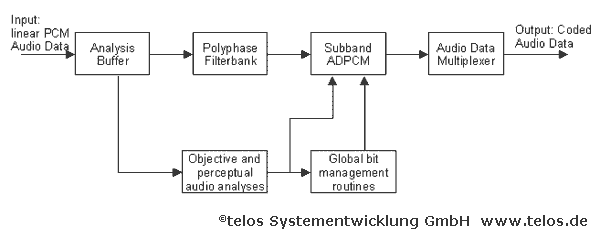DTS Encoder
The DTS audio coding is a perceptually optimized, differential sub-band coding using a set of coding technologies for audio data reduction.
 The DTS system design follows an asymmetric weighted complexity in the circuitry of the encoder stage. Therefore the coding algorithm can be executed with a high calculation effort. With this, the decoder can be designed relatively simple. The decoder merely follows instructions within the coded audio bit stream, generated by the encoder. This ensures that the encoding algorithm can be continually modified and improved and that these improvements automatically benefit every consumer decoder, because the decoder does not need to calculate parameters, which have an influence on the quality of the audio signal.
The DTS system design follows an asymmetric weighted complexity in the circuitry of the encoder stage. Therefore the coding algorithm can be executed with a high calculation effort. With this, the decoder can be designed relatively simple. The decoder merely follows instructions within the coded audio bit stream, generated by the encoder. This ensures that the encoding algorithm can be continually modified and improved and that these improvements automatically benefit every consumer decoder, because the decoder does not need to calculate parameters, which have an influence on the quality of the audio signal.
The size of the PCM analysis frame defines the buffer size and so the number of successive input samples to be used for the coding process to generate output samples. DTS uses 5 different frame sizes that are used according to the sampling frequency and the bit rate. The defined frame sizes are: 256, 512, 1024, 2048 and 4096 samples per frame.
If low bit rates are required, long frames are used to maximize coding efficiency and guarantee adequate sound quality. High bit rates are less critical to achieve enough coding efficiency, so shorter frames can be used.
 The filterbank de-correlates time-based audio samples and merges these samples into frequency-sorted sub-bands. A time to frequency transformation does not change the linear PCM data structure, thus each sub-band still consist of a linear PCM signal, but now with a restricted bandwidth. The transformation helps to identify the objective redundant information in the signal. Polyphase filters combine the advantages of excellent linearity, a high theoretical coding gain and excellent stop-band attenuation, with a low computational complexity. The number of sub-bands depends on the bandwidth of the original input signal, but in general the audio signal is divided into 32 uniform sub-bands.
The filterbank de-correlates time-based audio samples and merges these samples into frequency-sorted sub-bands. A time to frequency transformation does not change the linear PCM data structure, thus each sub-band still consist of a linear PCM signal, but now with a restricted bandwidth. The transformation helps to identify the objective redundant information in the signal. Polyphase filters combine the advantages of excellent linearity, a high theoretical coding gain and excellent stop-band attenuation, with a low computational complexity. The number of sub-bands depends on the bandwidth of the original input signal, but in general the audio signal is divided into 32 uniform sub-bands.
In each sub-band a differential coding (sub-band ADPCM) is done to remove objective redundant information from the signal. In parallel, psychoacoustic and transient analyses are performed on the original linear PCM signal to determine perceptually irrelevant information. The ADPCM is controlled by the bit management routine.
The reduced data signal is packed with additional control information into a defined DTS bit stream and is then ready to transmit.
